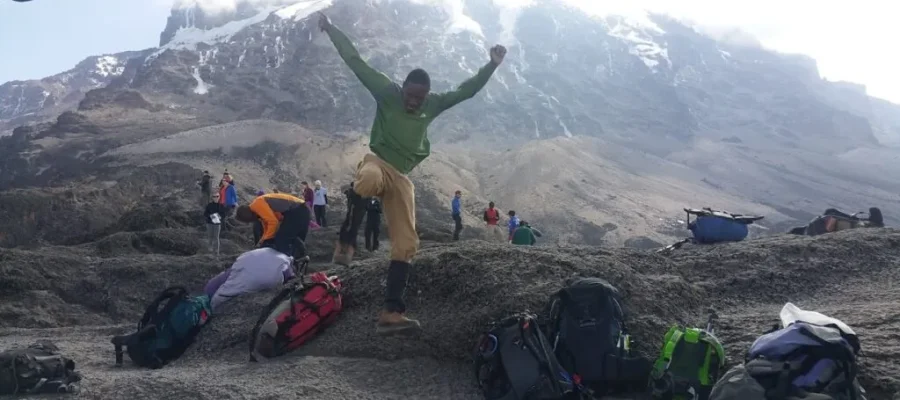6-Day Umbwe Route – Kilimanjaro Trekking Tour
A steep, direct, and dramatic route for experienced trekkers looking for a serious challenge on Kilimanjaro.

Why Choose the 6-Day Umbwe Route?
The Umbwe Route is the most challenging trail up Kilimanjaro—steep, short, and scenic. Known for its fast ascent, it offers little time for acclimatization, making it suitable only for fit, well-prepared trekkers or those with prior high-altitude experience. The route joins the Machame path at Barranco Camp, offering stunning views of the Southern Icefields and the summit approach from Barafu Camp.
| Feature | Details |
|---|---|
| Duration | 6 Days |
| Route Distance | ~53 km (33 miles) |
| Difficulty | Moderate |
| Accommodations | Tented Camps |
| Best Months | Jan–Mar & Jun–Oct |
6-Day Umbwe Route Itinerary
Altitude: 1,800m to 2,850m
Time: 5–6 hours
Habitat: Montane Forest
Begin your trek at Umbwe Gate and enter a dense, tropical forest. The trail is steep and narrow, climbing sharply as it follows a ridge between two rivers. You’ll be surrounded by towering trees, vines, and the calls of forest birds. The day ends at Umbwe Cave Camp, nestled in a serene woodland clearing.
Altitude: 2,850m to 3,950m
Time: 6–7 hours
Habitat: Heath & Moorland
The trail steepens as you exit the forest and climb along the ridge, with breathtaking views. Reach Barranco Camp below the iconic Barranco Wall, where the route joins the Machame path.
Altitude: 3,950m to 3,995m
Time: 4–5 hours
Habitat: Alpine Desert
Climb the Barranco Wall, a thrilling scramble with amazing views, then traverse valleys and ridges to Karanga Camp. This is a key acclimatization day.
Altitude: 3,995m to 4,673m
Time: 3–4 hours
Habitat: Alpine Desert
A short but steep trek takes you to Barafu Camp, your base for the summit attempt. Rest and prepare for your midnight climb to the roof of Africa.
Altitude: 4,673m to 5,895m (then down to 3,100m)
Time: 10–14 hours
Habitat: Arctic, then rainforest
Description: Midnight start. Reach Stella Point, then Uhuru Peak at sunrise. Celebrate at the summit. Long descent to Mweka Camp for overnight.
Altitude: 3,100m to 1,640m
Time: 3–5 hours
Habitat: Rainforest
Description: Final descent through lush forest. Receive summit certificates at the gate. Return transfer to Moshi or Arusha.
What’s Included in the 6-Day Trek
✅ Kilimanjaro park fees
✅ Rescue and camping fees
✅ Experienced guide, cook, and porters
✅ Mountain tents and sleeping mats
✅ All meals and drinking water
✅ Transfers to/from Kilimanjaro gate
What’s Not Included
❌ Flights to Tanzania
❌ Visa fees
❌ Gratuities for crew
❌ Personal gear (clothes, boots, sleeping bag, etc.)
| Group Size | Price per Person |
|---|---|
| 1 Trekker | $ 1,988 |
| 2–4 Trekkers | $1,770 |
| 5-9 Trekkers | $1,650 |
| 10+ Trekkers | $1,540 |
Discounts available for larger groups. Contact us for custom quotes.
Ready to Climb Kilimanjaro?
Secure Online Payments
We accept secure online payments for all confirmed bookings. To protect your payment, please only pay via the official payment link you receive from our official channels:
Request Payment via Email Request Payment via WhatsApp
Once your booking is confirmed, we require a 30% down payment to secure your spot. The remaining balance can be paid in cash or via POS machine when you arrive at your hotel or our office. This ensures your booking is reserved while giving you flexible payment options.
Why Trek Kilimanjaro With Tanzania Trip Service?
Local experienced guides
Focus on safety and proper acclimatization
High summit success rate
24/7 WhatsApp support
Faqs
A: The best route depends on your goals. Lemosho and Northern Circuit are great for acclimatization and scenery. Machame is popular and scenic, Marangu has huts, Rongai is dry and quiet, and Umbwe is very steep and challenging.
A: The Lemosho and Northern Circuit routes are considered the most scenic, offering panoramic views from all sides of Kilimanjaro.
A: The Northern Circuit has the highest summit success rate due to its long duration and excellent acclimatization profile.
A: Marangu offers hut accommodations and a gentle trail, but its shorter duration makes acclimatization more difficult. It's more comfortable but not necessarily easier to summit.
A: All routes except Marangu require camping. Marangu is the only route with mountain huts along the way.
A: 6 to 9 days is ideal. Shorter routes are possible but reduce summit success rates due to limited acclimatization time.
A: The best months are January to March and June to October, which are dry seasons with clear skies and stable weather.
A: Yes, guides are mandatory. Kilimanjaro National Park regulations require all climbers to be accompanied by licensed guides and a mountain crew.
A: You don’t need technical climbing skills, but you should be in good physical shape with strong endurance and mental determination.
A: Rongai, Northern Circuit, and parts of Lemosho are quieter and more remote, making them great options for avoiding crowds.
